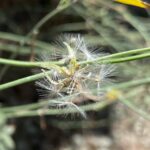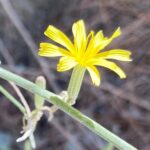Χόνδρυλλα η βουρλοειδής
Etymology of Chondrilla juncea: The name of the genus, Chondrilla, derives from Ancient Greek "χονδρίλη" [khondrili], which comes from "χόνδρος" [khondros] meaning "cartilage" + the suffix "-ίλη". It is also called "χονδρίλλα" [khondrilla] and "χόνδρυλλα" [khondrilla]. All names could be translated as "(a plant) of cartilages", referring to the cartilages that connect the fruit to the stems. Latin "juncea" means "made of rushes", a rather unfortunate epithet.
This is the only Chondrilla kind that appears in the wild Cypriot habitat.
Chondrilla juncea is considered a weed, with a root capable of choking the ones of other plants. In Cyprus, it is an indigenous, non-endemic plant encountered mostly in the western half of the island, up to an altitude of 1925 metres which means almost anywhere but the absolute top of Cyprus. Despite that its epithet "juncea'' means "made of rushes", in our country it is a plant that primarily grows on roadsides, which often lack water. In general, Chondrilla juncea in Cyprus appears to be a draught-tolerant plant.
In English, Chondrilla juncea is called "rush skeletonweed", because it is almost entirely naked from leaves, a feature that makes it unique to identify it. Multiple, tough stems appear leafless due to inconspicuous leaves and arise from a basal rosette of sharply lobed leaves. It is a perennial forb that can grow up to 120 cm tall. Its flowering period in Cyprus is between June and September, and at the end of the flower's life, a pappus appears.



